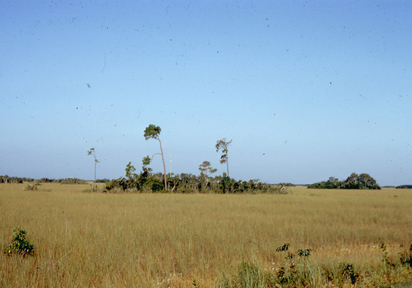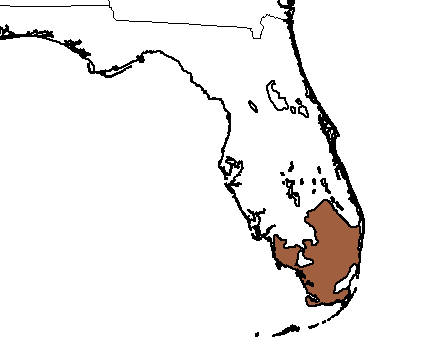
Hammocks, Everglades Ntl. Park, Florida (c) 2004 Maurice J. Kaufmann
Bioimages home (click on an image to enlarge)
view
this page in its intended navigation context
Everglades
(WWF
ecoregion
NT0904)

Hammocks, Everglades Ntl. Park, Florida
(c) 2004
Maurice J. Kaufmann

Source of bioregions data:
Olson, D. M. and
E. Dinerstein. The Global 200: Priority ecoregions for global conservation. (PDF
file) Annals of the Missouri Botanical Garden 89:125-126.
Distinctiveness (1=highest,4=lowest): 1
(globally outstanding)
This ecoregion contains an extraordinary variety of birds, reptiles, and plants
that occur nowhere else in the U.S. The sheet flow of water through the
marsh is unique in that it results from rainfall rather than river flooding.*
Conservation Status (1=most endangered, 5=most
intact): 3 (vulnerable)
Only 2% of the original ecosystem is truly intact, although about 30% could be
restored with proper management. Disruption of water flow by canals,
conversion to sugar cane cultivation, effects of pesticides and fertilizer, and
invasion by exotic species such as Schinus terebinthifoilius (Brazilian
pepper) are serious threats.*
Associated habitats**
hardwood hammock




(Left) Hammocks form where the limestone bedrock emerges above the water level
of the everglades. If bypassed by fire for a long time, hardwoods like
Swietinia mahagoni (mahognay) become established and form a jungle-like
"island". (center left) Epiphytes in a large hammock. (center right) Epiphytes
on mahogany in a large hammock. (right)
Ficus aurea (Florida strangler fig) enveloping a host tree. (c) 2004
Maurice J. Kaufmann
hires
hires
hires
hires
cypress dome or "head"


(left) Taxodium
distichum (bald cypress) becomes established in depressions in the
limestone bedrock. In the center where the depression and soil is deepest, the
trees are the tallest and they become successively smaller toward the edge of
the depression. This produces the "dome" shape. (right) Epiphytes on Taxodium
distichum.
(c) 2004 Maurice J. Kaufmann
hires
hires
coastal mangrove swamp


As the ground rises out of the ocean, a series of trees occurs according to
their tolerance for inundation. (left)
Rhizophora mangle (American or red mangrove) is the most tolerant of
submersion in salt water and grows in the mudflats where its roots are under
water at low tide. Avicennia germinans (black mangrove) grows in
the zone that is covered by high tides, but exposed at low tide. Laguncularia
racemosa (white mangrove) grows above the tidal zone as does Conocarpus
erectus (buttonwood) (right). (c) 2004
Maurice J. Kaufmann
hires
hires
* Ricketts, T.H., E. Dinerstein, D.M. Olson, C.J. Loucks, et al. (1999) Terrestrial Ecoregions of North America: A Conservation Assessment. World Wildlife Fund - United States and Canada. Island Press, Washington, D.C. pp. 310-313.
** George, J.C. (1972) Everglades Wildguide. Natural History Series, National Park Service, U.S. Dept. of the Interior.
Except as noted, images copyright 2002-2004 Steve Baskauf - Terms of use